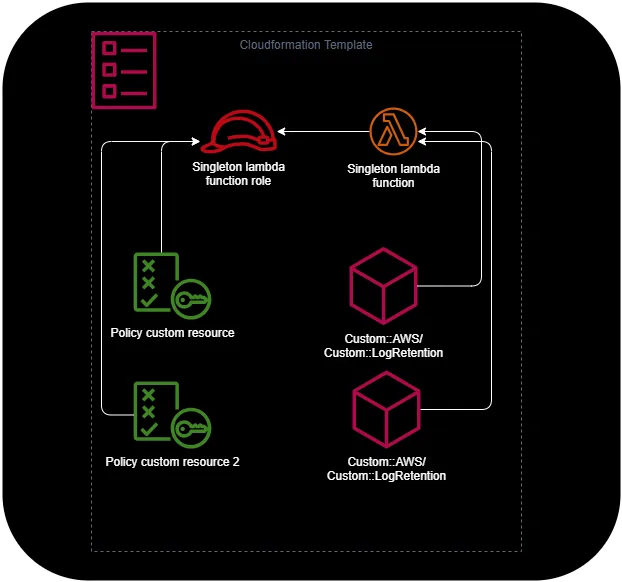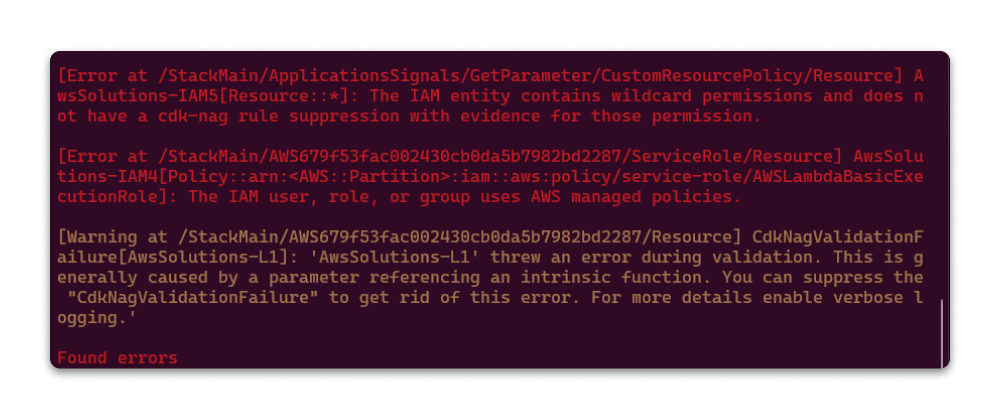Overview
When using AWS CDK with custom resources, CDK creates a singleton Lambda function that handles all custom resource operations. This Lambda function can trigger several cdk-nag findings, even if you’re not directly using custom resources in your stack. This article explains how to properly suppress these findings globally.
Understanding the Problem
How CDK Uses Custom Resources
CDK uses a shared Lambda function to handle all custom resources in your stack. Here’s a typical example of creating a custom resource:
new AwsCustomResource(this, "GetParameter", {
onUpdate: {
service: "SSM",
action: "GetParameter",
parameters: {
Name: "my-parameter",
WithDecryption: true,
},
physicalResourceId: PhysicalResourceId.of(Date.now().toString()),
},
functionName: "GetParameter",
policy: AwsCustomResourcePolicy.fromSdkCalls({
resources: AwsCustomResourcePolicy.ANY_RESOURCE,
}),
});Generated CloudFormation Components
When CDK synthesizes this code, it creates several CloudFormation resources:
- The custom resource itself
- An IAM policy for the custom resource
- An IAM role for the singleton Lambda function
- The singleton Lambda function
# The custom resource, which calling the singleton lambda function
"GetParameter42B0A00E": {
"Type": "Custom::AWS",
"Properties": {
"ServiceToken": {
"Fn::GetAtt": [
"AWS679f53fac002430cb0da5b7982bd22872D164C4C",
"Arn"
]
},
"Create": "{\"service\":\"SSM\",\"action\":\"GetParameter\",\"parameters\":{\"Name\":\"my-parameter\",\"WithDecryption\":true},\"physicalResourceId\":{\"id\":\"1736701660301\"}}",
"Update": "{\"service\":\"SSM\",\"action\":\"GetParameter\",\"parameters\":{\"Name\":\"my-parameter\",\"WithDecryption\":true},\"physicalResourceId\":{\"id\":\"1736701660301\"}}",
"InstallLatestAwsSdk": false
},
"DependsOn": [
"GetParameterCustomResourcePolicyD8E5D455"
],
"UpdateReplacePolicy": "Delete",
"DeletionPolicy": "Delete",
"Metadata": {
"aws:cdk:path": "StackMain/GetParameter/Resource/Default"
}
},
# The policy which is attached to the singleton lambda function role
"GetParameterCustomResourcePolicyD8E5D455": {
"Type": "AWS::IAM::Policy",
"Properties": {
"PolicyDocument": {
"Statement": [
{
"Action": "ssm:GetParameter",
"Effect": "Allow",
"Resource": "*"
}
],
"Version": "2012-10-17"
},
"PolicyName": "GetParameterCustomResourcePolicyD8E5D455",
"Roles": [
{
"Ref": "AWS679f53fac002430cb0da5b7982bd2287ServiceRoleC1EA0FF2"
}
]
},
"UpdateReplacePolicy": "Delete",
"DeletionPolicy": "Delete",
"Metadata": {
"aws:cdk:path": "StackMain/GetParameter/CustomResourcePolicy/Resource"
}
},
# The role for the singleton lambda function
# Causing the finding AWSSolution-IAM4, because of the used managed policy
"AWS679f53fac002430cb0da5b7982bd2287ServiceRoleC1EA0FF2": {
"Type": "AWS::IAM::Role",
"Properties": {
"AssumeRolePolicyDocument": {
"Statement": [
{
"Action": "sts:AssumeRole",
"Effect": "Allow",
"Principal": {
"Service": "lambda.amazonaws.com"
}
}
],
"Version": "2012-10-17"
},
"ManagedPolicyArns": [
{
"Fn::Join": [
"",
[
"arn:",
{
"Ref": "AWS::Partition"
},
":iam::aws:policy/service-role/AWSLambdaBasicExecutionRole"
]
]
}
]
},
"UpdateReplacePolicy": "Delete",
"DeletionPolicy": "Delete",
"Metadata": {
"aws:cdk:path": "StackMain/AWS679f53fac002430cb0da5b7982bd2287/ServiceRole/Resource"
}
},
# The lambda function which is used for all custom resources
"AWS679f53fac002430cb0da5b7982bd22872D164C4C": {
"Type": "AWS::Lambda::Function",
"Properties": {
"Code": {
"S3Bucket": {
"Fn::Sub": "cdk-hnb659fds-assets-${AWS::AccountId}-${AWS::Region}"
},
"S3Key": "ce2f3595a340d6c519a65888ef97e3b9b64f053f83608e32cc28162e22d7d99a.zip"
},
"FunctionName": "GetParameter",
"Handler": "index.handler",
"Role": {
"Fn::GetAtt": [
"AWS679f53fac002430cb0da5b7982bd2287ServiceRoleC1EA0FF2",
"Arn"
]
},
"Runtime": {
"Fn::FindInMap": [
"LatestNodeRuntimeMap",
{
"Ref": "AWS::Region"
},
"value"
]
},
"Timeout": 120
},
"DependsOn": [
"AWS679f53fac002430cb0da5b7982bd2287ServiceRoleC1EA0FF2"
],
"UpdateReplacePolicy": "Delete",
"DeletionPolicy": "Delete",
"Metadata": {
"aws:cdk:path": "StackMain/AWS679f53fac002430cb0da5b7982bd2287/Resource",
"aws:asset:path": "asset.ce2f3595a340d6c519a65888ef97e3b9b64f053f83608e32cc28162e22d7d99a",
"aws:asset:is-bundled": false,
"aws:asset:property": "Code"
}
},This will be the linked resources if there a two custom resources in the stack.

cdk-nag Findings
This configuration triggers three main findings from cdk-nag:
[Error at /StackMain/ApplicationsSignals/GetParameter/CustomResourcePolicy/Resource] AwsSolutions-IAM5[Resource::*]: The IAM entity contains wildcard permissions and does not have a cdk-nag rule suppression with evidence for those permission.
[Error at /StackMain/AWS679f53fac002430cb0da5b7982bd2287/ServiceRole/Resource] AwsSolutions-IAM4[Policy::arn:<AWS::Partition>:iam::aws:policy/service-role/AWSLambdaBasicExecutionRole]: The IAM user, role, or group uses AWS managed policies.
[Warning at /StackMain/AWS679f53fac002430cb0da5b7982bd2287/Resource] CdkNagValidationFailure[AwsSolutions-L1]: 'AwsSolutions-L1' threw an error during validation.Why Resource-Level Suppression Isn’t Enough
A simple resource-level suppression like this only handles the AwsSolutions-IAM5 finding:
NagSuppressions.addResourceSuppressions(
customResource,
[
{
id: "AwsSolutions-IAM5",
reason: "Policy Creation derived from SdkCalls are OK",
},
],
true,
);This doesn’t work for the other findings because the singleton Lambda function is attached to the root of the stack and requires a different suppression approach.
The Solution
Overview
To properly suppress all findings related to the custom resource singleton Lambda, we need to:
- Identify all possible paths where the custom resource creates resources
- Check if these paths exist in our stack
- Apply suppressions only to existing paths
Implementation
Here’s the complete solution:
const suppressions: NagPackSuppression[] = [
{
id: "AwsSolutions-IAM4",
reason: "Custom resource singleton lambda",
},
{
id: "AwsSolutions-L1",
reason: "Custom resource singleton lambda",
},
];
const stack = Stack.of(this);
// The UUID is a fixed value used by CDK for custom resources
const customResourceId = `AWS${AwsCustomResource.PROVIDER_FUNCTION_UUID.split("-").join("")}`;
const stackName = stack.stackName;
// Define all possible paths that could trigger cdk-nag findings
const customResourceSuppressPaths = new Set([
`/${stackName}/${customResourceId}/ServiceRole/Resource`,
`/${stackName}/${customResourceId}/Resource`,
]);
// Get all existing paths in the stack
const allExistingPaths = new Set(
stack.node.findAll().map((node) => `/${node.node.path}`),
);
// Apply suppressions only to paths that exist
for (const path of customResourceSuppressPaths) {
if (allExistingPaths.has(path)) {
NagSuppressions.addResourceSuppressionsByPath(
stack,
path,
suppressions,
true,
);
}
}Benefits
This solution:
- Handles all cdk-nag findings related to the singleton Lambda
- Works whether you’re directly using custom resources or not
- Prevents errors from trying to suppress non-existent paths
- Can be implemented centrally in your stack
Additional Resources
If you’re using a custom NagPack, you can find implementation examples here.
